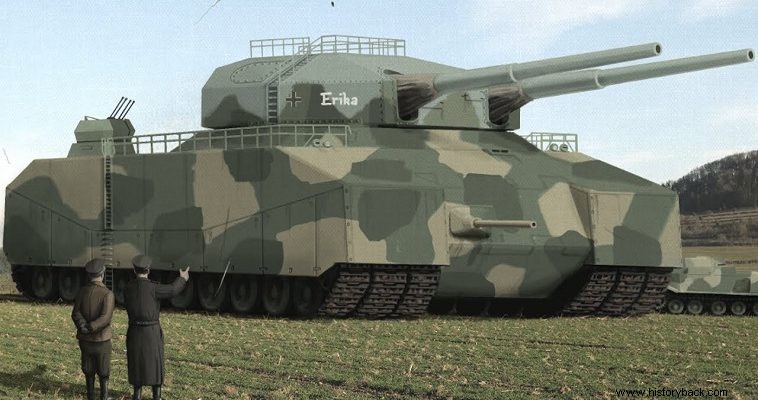
The Lankreuzer (Land Cruiser) P. 1000 "Ratte" (Rat) would be the most powerful land-based warship ever built by man. It was a "battle tank", a real cruiser, with ship engines and battleship armament! It was a proposal by Krupp director Eduard Grote that was submitted in June 1942. Along with the proposal, the plans for the "land cruiser" were submitted. The vehicle would weigh 1,000 tons, the same as a small destroyer. Of course the plan received Hitler's immediate approval.
The story began in 1941 when Krupp, studying Soviet tanks, concluded that the German army needed heavier tanks than the then-in-service Pz IV. This study resulted in the design of the 188-ton super-heavy Maus tank, two of which were built, and the Ratte, which fortunately remained on paper. The Ratte would carry two 280 mm naval guns as its main armament. in a twin turret configuration similar to that of battleships (or battle cruisers) of the "Scharnhorst" class and a maximum armor thickness of 250 mm.
Despite Hitler's approval, Minister of Armaments Speer canceled the program in 1943 as he considered it simply a waste of valuable resources. It is worth noting that Krupp had also presented the P. 1500 design for a self-propelled 800 mm super-gun. The Ratte would weigh, as reported, 1,000 tons. Its guns alone would weigh 100 tons and the tower would weigh another 200 tons. The armor would weigh another 200 tons. The plan called for a carriage 35 m long by 14 m wide and 11 m high. The crawlers would each be 7.2 m wide.
The tank was intended to have either two MAN V12Z32/44-24 diesel engines of 8,400 hp each, which were used on large German submarines, or eight smaller ones of 2,000 hp. The machines would be fitted with snorkels to aid in the oxygen supply. The tank would have two 280mm guns. SK C/28, one 128mm gun, two Mauser MG 151mm heavy machine guns and eight 20mm anti-aircraft guns. The tank would also carry two motorcycles that would act as an "organic" reconnaissance team.
But its sheer size meant that it simply couldn't cross any bridge, nor could it cross any road without destroying it. Although its maximum speed would be 40 km/h. however it would present a formidable target to enemy aircraft and artillery. The autonomy of the end would not be satisfactory due to the huge fuel consumption.
